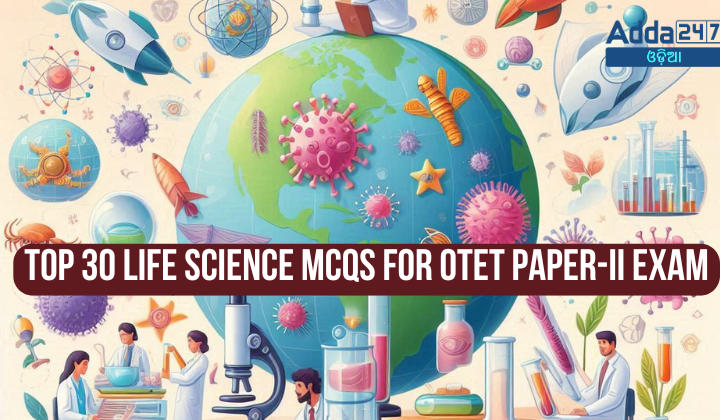Top 30 Life Science MCQS For OTET Paper-II Exam
- The natural process through which organisms adapt to new surroundings is known as:
(a) Evolution
(b) Adaptation
(c) Migration
(d) Mutation
Ans. (b) Adaptation - Which scientist suggested that creatures evolved by adjusting to their circumstances?
(a) Charles Darwin
(b) Alfred Wallace
(c) Georges Louis Leclerc Comte de Buffon
(d) Jean-Baptiste Lamarck
Ans. (c) Georges Louis Leclerc Comte de Buffon - What type of adaptation involves modifications to an organism’s structure?
(a) Behavioural adaptation
(b) Physiological adaptation
(c) Structural adaptation
(d) Co-adaptation
Ans. (c) Structural adaptation - Birds migrating south in winter exhibit what type of adaptation?
(a) Structural adaptation
(b) Behavioural adaptation
(c) Physiological adaptation
(d) Co-adaptation
Ans. (b) Behavioural adaptation - What is a physiological adaptation in animals living in cold climates?
(a) Long beaks
(b) Thick coats
(c) Migrating south
(d) Storing water
Ans. (b) Thick coats - Which of the following is an example of co-adaptation?
(a) Camouflage in octopuses
(b) Long beaks in hummingbirds
(c) Shivering in cold climates
(d) Migrating birds
Ans. (b) Long beaks in hummingbirds - Which adaptation is common in animals living in desert regions?
(a) Hibernation
(b) Nocturnal activity
(c) Mimicry
(d) Long fur
Ans. (b) Nocturnal activity - What allows dolphins to locate neighboring animals underwater?
(a) Gills
(b) Blowholes
(c) Echolocation
(d) Camouflage
Ans. (c) Echolocation - Animals like tigers in grasslands have evolved what feature for survival?
(a) Storing water
(b) Stripes for camouflage
(c) Thick fur
(d) Hibernation
Ans. (b) Stripes for camouflage - Mimicry in butterflies to avoid predators is an example of:
(a) Structural adaptation
(b) Behavioural adaptation
(c) Physiological adaptation
(d) Co-adaptation
Ans. (b) Behavioural adaptation - What is the main purpose of respiration in plants?
(a) To produce oxygen
(b) To generate glucose
(c) To release energy for cellular activities
(d) To absorb sunlight
Ans. (c) To release energy for cellular activities - Which structures in plants are primarily involved in gaseous exchange?
(a) Chloroplasts and mitochondria
(b) Stomata and lenticels
(c) Xylem and phloem
(d) Roots and flowers
Ans. (b) Stomata and lenticels - How do roots of plants respire?
(a) By using oxygen dissolved in water
(b) By using oxygen from the air gaps in the soil
(c) Through photosynthesis
(d) By producing their own oxygen
Ans. (b) By using oxygen from the air gaps in the soil - Which process is different between plants and animals when it comes to respiration?
(a) Both use oxygen
(b) Both release carbon dioxide
(c) Both use specialized structures for gas exchange
(d) Plants do not have specialized structures like animals for gas exchange
Ans. (d) Plants do not have specialized structures like animals for gas exchange - Why is it not advisable to sleep under a tree at night?
(a) Trees release oxygen at night
(b) Trees release carbon dioxide at night
(c) Trees absorb all the oxygen around them at night
(d) Trees release harmful gases at night
Ans. (b) Trees release carbon dioxide at night - During which part of the day is photosynthesis most active in plants?
(a) Nighttime
(b) Morning only
(c) Daytime
(d) Evening only
Ans. (c) Daytime - What are the products of aerobic respiration in plants?
(a) Water, oxygen, and glucose
(b) Carbon dioxide, water, and energy
(c) Ethyl alcohol and carbon dioxide
(d) Glucose and oxygen
Ans. (b) Carbon dioxide, water, and energy - Which type of respiration occurs in the absence of oxygen?
(a) Aerobic respiration
(b) Anaerobic respiration
(c) Photosynthesis
(d) Glycolysis
Ans. (b) Anaerobic respiration - How do lenticels in stems function in respiration?
(a) They perform photosynthesis
(b) They release energy
(c) They facilitate gaseous exchange
(d) They store water
Ans. (c) They facilitate gaseous exchange - Which of the following best describes the relationship between photosynthesis and respiration in plants?
(a) Both processes only occur during the daytime
(b) Photosynthesis stores energy, while respiration releases energy
(c) Both processes require chlorophyll
(d) Respiration only occurs in non-green parts of the plant
Ans. (b) Photosynthesis stores energy, while respiration releases energy - Which of the following is a commercial use of forests?
(a) Regulation of the hydrological cycle
(b) Soil conservation
(c) Production of oxygen
(d) Timber production
Ans. (d) Timber production - What is the main greenhouse gas absorbed by forests during photosynthesis?
(a) Methane
(b) Carbon dioxide
(c) Nitrous oxide
(d) Ozone
Ans. (b) Carbon dioxide - Approximately what percentage of the Earth’s land surface is covered by forests?
(a) 10%
(b) 30%
(c) 50%
(d) 70%
Ans. (b) 30% - Which of the following is not a major cause of deforestation?
(a) Shifting cultivation
(b) Urbanization
(c) Soil conservation
(d) Mining
Ans. (c) Soil conservation - Which practice involves clearing land for cultivation and then abandoning it after a few years?
(a) Logging
(b) Shifting cultivation
(c) Overgrazing
(d) Urbanization
Ans. (b) Shifting cultivation - What ecological service provided by forests helps in reducing global warming?
(a) Production of oxygen
(b) Habitat for wildlife
(c) Absorption of carbon dioxide
(d) Soil conservation
Ans. (c) Absorption of carbon dioxide - Which of the following is a consequence of deforestation?
(a) Increase in biodiversity
(b) Enhanced soil fertility
(c) Increased risk of floods
(d) Stabilization of climate
Ans. (c) Increased risk of floods - What is one of the main reasons forests are referred to as the “lungs of the Earth”?
(a) They produce oxygen through photosynthesis
(b) They regulate the hydrological cycle
(c) They provide timber and fuelwood
(d) They prevent soil erosion
Ans. (a) They produce oxygen through photosynthesis - Which activity is known to cause forest fires leading to deforestation?
(a) Urbanization
(b) Overgrazing
(c) Logging
(d) Extreme weather conditions
Ans. (d) Extreme weather conditions - What is a recommended solution to combat deforestation?
(a) Increase shifting cultivation
(b) Ban on planting new trees
(c) Implement laws against illegal logging
(d) Promote deforestation for urban development
Ans. (c) Implement laws against illegal logging





